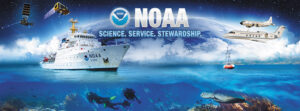 Let’s Celebrate This Great Organization.
Let’s Celebrate This Great Organization. Here is a description of the NOAA agency:
NOAA is an agency that enriches life through science. Its reach goes from the surface of the sun to the depths of the ocean floor as they work to keep the public informed of the changing environment around them. From daily weather forecasts, severe storm warnings, and climate monitoring to fisheries management, coastal restoration and supporting marine commerce, NOAA’s products and services support economic vitality and affect more than one-third of America’s gross domestic product. NOAA’s dedicated scientists use cutting-edge research and high-tech instrumentation to provide citizens, planners, emergency managers and other decision makers with reliable information they need when they need it.
NOAA’s mission of science, service and stewardship spans from the surface of the sun to the depths of the ocean. Their mission:
1. To understand and predict changes in climate, weather, oceans and coasts;
2. To share that knowledge and information with others; and
3. To conserve and manage coastal and marine ecosystems and resources.
To understand and predict changes in climate, weather, oceans and coasts
Science at NOAA is the systematic study of the structure and behavior of the ocean, atmosphere, and related ecosystems; integration of research and analysis; observations and monitoring; and environmental modeling. NOAA science includes discoveries and ever new understanding of the oceans and atmosphere, and the application of this understanding to such issues as the causes and consequences of climate change, the physical dynamics of high-impact weather events, the dynamics of complex ecosystems and biodiversity, and the ability to model and predict the future states of these systems. Science provides the foundation and future promise of the service and stewardship elements of NOAA’s mission.
 To share that knowledge and information with others
To share that knowledge and information with others Service is the communication of NOAA’s research, data, information, and knowledge for use by the Nation’s businesses, communities, and people’s daily lives. NOAA services include climate predictions and projections; weather and water reports, forecasts and warnings; nautical charts and navigational information; and the continuous delivery of a range of Earth observations and scientific data sets for use by public, private, and academic sectors.
To conserve and manage coastal and marine ecosystems and resources
Stewardship is NOAA’s direct use of its knowledge to protect people and the environment, as the Agency exercises its direct authority to regulate and sustain marine fisheries and their ecosystems, protect endangered marine and anadromous species, protect and restore habitats and ecosystems, conserve marine sanctuaries and other protected places, respond to environmental emergencies, and aid in disaster recovery. The foundation of NOAA’s long-standing record of scientific, technical, and organizational excellence is its people. NOAA’s diverse functions require an equally diverse set of skills and constantly evolving abilities in its workforce.
Also underlying NOAA’s continued success is its unique infrastructure. NOAA’s core mission functions require satellite systems, ships, buoys, aircraft, research facilities, high-performance computing, and information management and distribution systems. The agency provides research-to-application capabilities that can recognize and apply significant new understanding to questions, develop research products and methods, and apply emerging science and technology to user needs. NOAA invests in and depends heavily on the science, management, and engagement capabilities of its partners. Collectively, NOAA’s organizational enterprise-wide capabilities — its people, infrastructure, research, and partnerships — are essential for NOAA to achieve its vision, mission, and long-term goals.
NOAA’s Vision of the Future
1. Resilient Ecosystems, Communities, and Economies; and
2. Healthy ecosystems, communities and economies that are resilient in the face of change.
Earth’s ecosystems support people, communities, and economies. Our own human health, prosperity, and well-being depend upon the health and resilience of natural and social ecosystems. Managing this interdependence requires timely and usable scientific information to make decisions. Human well-being requires preparing for and responding to changes within these natural systems. NOAA’s mission of science, service, and stewardship is directed to a vision of the future where societies and their ecosystems are healthy and resilient in the face of sudden or prolonged change.
A vision of resilience will guide NOAA and its partners in a collective effort to reduce the vulnerability of communities and ecological systems in the short-term, while helping society avoid or adapt to potential long-term environmental, social, and economic changes. To achieve this vision we must understand current Earth system conditions, project future changes, and help people make informed decisions that reduce their vulnerability to environmental hazards and stresses that emerge over time, while at the same time increase their ability to cope with them. Resilient human communities and economies maintain or improve their health and vitality over time by anticipating, absorbing, diffusing, and adapting to change. Resilient communities and institutions derive goods from ecosystems in a way that does not compromise ecosystem integrity, yet is economically feasible and socially just for future generations.
To this end, NOAA will focus on four long-term goals that are central determinants of resilient ecosystems, communities, and economies — and that cannot be achieved without the agency’s distinctive mission and capabilities. The objectives identified in NOAA’s Next-Generation Strategic Plan are the basis for NOAA’s corporate planning, performance management, and stakeholder engagement over the next five years. Objectives are specific outcomes NOAA can achieve on the path to broader, long-term goals and toward a more capable, flexible enterprise. They are measureable and can be affected by specified activities over a five-year period.
NOAA’s Line Offices and Staff Offices will be accountable for executing the strategy laid out in this document through implementation plans at a tactical (rather than strategic) level of detail. Where there are shared capabilities to achieve an objective, there will also be joint accountability for budgeting, executing, and performing toward that objective. Their history NOAA’s roots reach back more than 200 years: They are America’s environmental intelligence agency.
In 1807, President Thomas Jefferson founded the U.S. Coast and Geodetic Survey (as the Survey of the Coast) to provide nautical charts to the maritime community for safe passage into American ports and along our extensive coastline. The Weather Bureau was founded 1870 and, one year later, the U.S. Commission of Fish and Fisheries was founded. Individually, these organizations were America’s first physical science agency, America’s first agency dedicated specifically to the atmospheric sciences, and America’s first conservation agency.















Follow Us